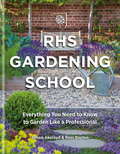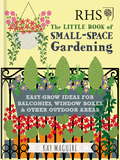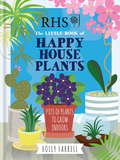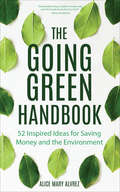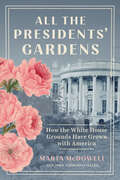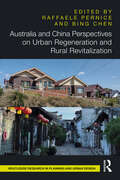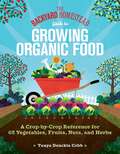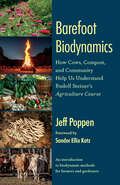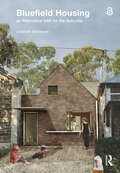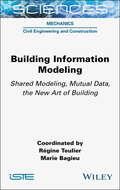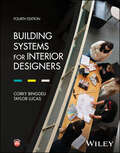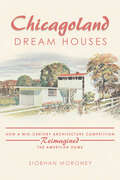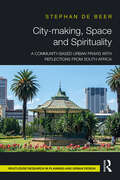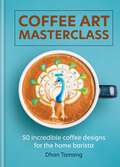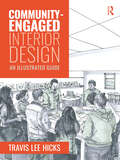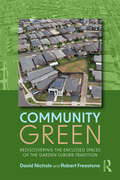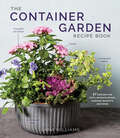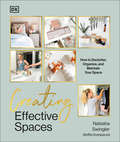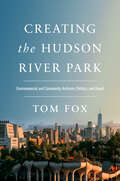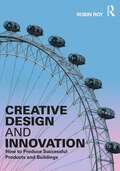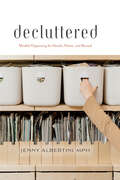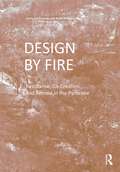- Table View
- List View
RHS Gardening School: Everything You Need to Know to Get the Most from Your Garden
by Simon Akeroyd Dr Ross BaytonKeen amateur gardeners and aspiring professionals can learn from the expertise of the RHS with this handy guide.It doesn't matter if you're an old hand at gardening or just starting out, there are always things to discover and opportunities to improve, whether it's mastering a new technique or brushing up on your botany.RHS Gardening School is the perfect guide for gardeners who want to learn. Inside you'll find chapters on:Understanding plants Everyday garden care Problem solvingPlanting designGardening through the yearand much more. Hands-on guidance and step-by-step instructions explain topics such as pruning, pest and diseases, weed removal and caring for lawns. Expert gardeners explain the underlying principles in plain English, while clear diagrams and beautiful photographs inspire and inform.Become a better, smarter, more productive gardener with this complete guide to horticulture in one handy book.
RHS Little Book of Small-Space Gardening: Easy-grow Ideas for Balconies, Window Boxes & Other Outdoor Areas
by Kay MaguireMake the most of your balconies and windowsills with this handy gardening guide from the author of the award-winning RHS Grow Your Own Crops in Pots.RHS Little Book of Small-space Gardening is packed with practical information and inspirational ideas for anyone who wants to grow plants in a variety of outside spaces, from balconies to stairways, windowsills to doorsteps. Look inside to discover a host of creative step-by-step projects, such as speedy salads, wildlife pots, fragrant baskets and green garden walls. Handy plant profiles tell you what's best to grow in a variety of conditions, such as wind, shade and drought.Whether you choose to start with a simple pot or tackle a more ambitious project, with this beautifully illustrated book you'll soon see how even the smallest spaces can be amazing growing spaces.
RHS Little Book of Happy Houseplants
by Holly FarrellGrowing indoors has never been easier or more fun. Become a star gardener without leaving your home with this beginner's guide to houseplants for the whole family.Whatever the size of your home, and even if you don't have much spare time on your hands, house plants are an exciting way to bring some low-maintenance greenery into your life. As well as looking luscious, house plants improve air quality and our sense of well-being - and caring for them is an endlessly enchanting hobby for both adults and children. See how a knobbly ginger root sprouts huge exotic leaves, or how plants can grow without any soil at all. Children can get up close and personal with the natural world and try their hand at growing with ease. Best of all, the plants provide year-round interest and there's never any need to go out into the rain. In RHS Little Book of Happy House Plants, every technique and project is explained and illustrated in clear, down-to-earth steps. Even beginners will want to have a go!
The Going Green Handbook: 52 Inspired Ideas for Saving Money and the Environment
by Alice Mary AlvrezEasy, healthy, money-saving DIY ideas for a sustainable lifestyle Inspired living for the environment: Make your footprint planet-positive. With the gentle guidance of eco-expert, Alice Mary Alvrez, you can start with baby steps and progress to living the green good life! Level up your eco-knowledge with these 52 creative ideas and easy ways to reduce your waste, eat organic, and keep toxins out of your home. Grow organic, reduce waste, live toxin-free, and save money: Inside this helpful and hopeful guide, you'll find tips for greening up all the areas of your life. Learn surprising facts about your impact on the environment and change your habits with do-it-yourself ideas. Start with small, simple changes and work your way up to raising chickens, planting a bee-friendly garden, and growing organic veggies instead of a high maintenance grass lawn. Also find easy composting tips and recipes for toxin-free homemade eco cleansers and paint. A DIY handbook for all levels: Whether you want to be a green rookie or an eco-master, you can help the planet every week of the year. The Going Green Handbook is an inspiring and instructive guide to living the handmade life by consuming less and creating more. Use little, live big! Readers will learn: why we live the way we do and how we can become less wasteful and greener tips, tricks and secrets for a self-sufficient sustainable home and lifestyle starter garden tips for growing your own healthy food, fruit, veggies, and fresh herbs how to save money by going green Save money, be inspired, and go green with this helpful and easy handbook!
All the Presidents' Gardens: How the White House Grounds Have Grown with America
by Marta McDowellThis New York Times bestseller shares the rich history of the White House grounds, revealing how the story of the garden is also the story of America. The 18-acres surrounding the White House have been an unwitting witness to history—kings and queens have dined there, bills and treaties have been signed, and presidents have landed and retreated. Throughout it all, the grounds have remained not only beautiful, but also a powerful reflection of American trends. In All the Presidents' Gardens bestselling author Marta McDowell tells the untold history of the White House grounds with historical and contemporary photographs, vintage seeds catalogs, and rare glimpses into Presidential pastimes. History buffs will revel in the fascinating tidbits about Lincoln&’s goats, Ike's putting green, Jackie's iconic roses, Amy Carter's tree house, and Trump's controversial renovations. Gardeners will enjoy the information on the plants whose favor has come and gone over the years and the gardeners who have been responsible for it all. As one head gardener put it, &“What&’s great about the job is that our trees, our plants, our shrubs, know nothing about politics.&”
Australia and China Perspectives on Urban Regeneration and Rural Revitalization (Routledge Research in Planning and Urban Design)
by Raffaele Pernice Bing ChenThis edited volume reviews important contemporary issues through relevant case studies and research in China and Australia, such as the challenges posed by climate change, the development of eco-urban design, research on sustainable habitats and the relationship between ecology, green architecture and city regeneration, as well as, in general, the future of the city in the new millennium.The authors represent a broad selection of international experts, young scholars and established academics who discuss themes related to urban–rural destruction and economic and spatial regeneration techniques, the sustainable reconversion of natural landscapes and eco-urban design in the context of the current evolution of architectural and urbanism practice. The book aims to explain the conditions in which the contemporary debate about urban regeneration and rural revitalisation has developed in Australia and China, presented by different theoretical and methodological perspectives. It also provides a multifaceted and critical analysis of relevant case studies and urban experiences in Australia and China, focusing on environmental disruption, resized urban interventions and the need for more efficient and sustainable forms of regeneration and urban renewal practice in urban–rural contexts.This book will be an invaluable resource for architects, planners, architectural and urban historians, geographers, and scholars interested in modern Australian and Chinese architecture and urbanism.
The Backyard Homestead Guide to Growing Organic Food: A Crop-by-Crop Reference for 62 Vegetables, Fruits, Nuts, and Herbs
by Tanya Denckla CobbThis essential guide to growing a bountiful food garden includes detailed seed-starting, growing, and harvesting information for 62 vegetables, fruits, and herbs, a complete companion-planting guide, and organic pest-control handbook. The latest addition to Storey's bestselling Backyard Homestead series, The Backyard Homestead Guide to Growing Organic Food is a one-stop reference for all the key information food gardeners need to grow a healthy, bountiful garden. Author Tanya Denckla Cobb presents key information based on extensive research and years of experience, including when to start seeds for each type of crop (and at what temperature), how far apart to space seedlings, how to tell when a crop is ready to harvest, and notes on preservation. The book features a comprehensive companion planting guide and an in-depth review of the most effective organic pest control practices, including recipes for how to make your own pest deterrent sprays.
Barefoot Biodynamics: How Cows, Compost, and Community Help Us Understand Rudolf Steiner’s Agriculture Course
by Jeff PoppenWith decades of knowledge and proven, common-sense methods from “The Barefoot Farmer,” this practical guide to biodynamic principles and practices will appeal to growers of every scale and experience level. In Barefoot Biodynamics, organic grower Jeff Poppen—“The Barefoot Farmer”—combines tales from his personal history in rural Tennessee with the practical applications of biodynamic principles and the deep aspects of the biodynamic methods that continue to make his farm a success today. Jeff’s friendly, direct, and humorous writing will appeal not only to the biodynamic-curious, but also to farmers and gardeners who have experimented with the biodynamic approach and are looking for a deeper understanding of the practice. Rooted in the teachings of biodynamic pioneer Rudolf Steiner, Jeff’s unique insights and deep reflections on “guiding lines” of biodynamic growing are an invaluable resource. Those “guiding lines” include: producing a farm’s fertility using cover crops, compost, and other on-farm inputs enjoying the renewing power of farm festivals augmenting scientific knowledge with the power of observation and intuition avoiding chemical fertilizers understanding that carbon, oxygen, nitrogen, and hydrogen make up 95 percent of the physical structure of plants and are freely available in the air around us enhancing the availability of critical minerals such as silica and lime through good farming practices building humus-rich soil teeming with microbial life using homeopathic preparations to heal and enrich the soil In addition, Jeff walks the reader through the eight lectures on farming given by Steiner in 1924, summarizing important points from each lecture and “translating” them from Steiner’s profound yet sometimes impenetrable vocabulary into plain language. In Barefoot Biodynamics, Jeff provides new insight into these enigmatic lectures, revealing an often overlooked yet cost-effective farming method rooted in common sense.
Bluefield Housing as Alternative Infill for the Suburbs
by Damian MadiganSuburbanised cities share a common dilemma: how to transition to more densely populated and socially connected urban systems while retaining low-rise character, avoiding gentrification, and opening neighbourhoods to more diverse housing choices. Bluefield Housing offers a new land definition and co-located infill model addressing these concerns, through describing and deploying the types of ad-hoc modifications that have been undertaken in the suburbs for decades. Extending green-, brown-, and greyfield definitions, it provides a necessary middle ground between the ‘do nothing’ attitude of suburban preservation and the ‘do everything’ approach of knock-down-rebuild regeneration. An adjunct to ‘missing middle’ and subdivision densification models, with a focus on co-locating homes on small lots, Bluefield Housing presents a unified design approach to suburban infill: retrofitting original houses, retaining and enhancing landscape and urban tree canopies, and delivering additional homes as low-rise additions and backyard homes suited to the increasingly complex make-up of our households. Extensively illustrated by the author with engaging architectural design studies, Damian Madigan describes how existing quirks of suburban housing can prompt new forms of infill, explains why a new suburban densification model is not only necessary but can be made desirable for varied stakeholders, and charts a path towards the types of statutory and market triggers required to make bluefield housing achievable. Using Australian housing as an example but addressing universal concerns around neighbourhood character, demographic needs, housing diversity, dwelling flexibility, and landscape amenity, Bluefield Housing offers innovative suburban infill ideas for policy makers, planners, architects, researchers and students of housing and design studies, and for those with a stake in the future of the suburbs.
Bluefield Housing as Alternative Infill for the Suburbs
by Damian MadiganSuburbanised cities share a common dilemma: how to transition to more densely populated and socially connected urban systems while retaining low-rise character, avoiding gentrification, and opening neighbourhoods to more diverse housing choices. Bluefield Housing offers a new land definition and co-located infill model addressing these concerns, through describing and deploying the types of ad-hoc modifications that have been undertaken in the suburbs for decades. Extending green-, brown-, and greyfield definitions, it provides a necessary middle ground between the ‘do nothing’ attitude of suburban preservation and the ‘do everything’ approach of knock-down-rebuild regeneration.An adjunct to ‘missing middle’ and subdivision densification models, with a focus on co-locating homes on small lots, Bluefield Housing presents a unified design approach to suburban infill: retrofitting original houses, retaining and enhancing landscape and urban tree canopies, and delivering additional homes as low-rise additions and backyard homes suited to the increasingly complex make-up of our households.Extensively illustrated by the author with engaging architectural design studies, Damian Madigan describes how existing quirks of suburban housing can prompt new forms of infill, explains why a new suburban densification model is not only necessary but can be made desirable for varied stakeholders, and charts a path towards the types of statutory and market triggers required to make bluefield housing achievable. Using Australian housing as an example but addressing universal concerns around neighbourhood character, demographic needs, housing diversity, dwelling flexibility, and landscape amenity, Bluefield Housing offers innovative suburban infill ideas for policy makers, planners, architects, researchers and students of housing and design studies, and for those with a stake in the future of the suburbs.The Open Access version of this book, available at www.taylorfrancis.com, has been made available under a Creative Commons Attribution-Non Commercial-No Derivatives (CC-BY-NC-ND) 4.0 license.
Building Information Modeling: Shared Modeling, Mutual Data, the New Art of Building
by Régine Teulier Marie BagieuThis book presents how Building Information Modeling (BIM) and the use of shared representation of built assets facilitate design, construction and operation processes (ISO 19650). The modeling of public works data disrupts the art of construction. Written by both academics and engineers who are heavily involved in the French research project Modélisation des INformations INteropérables pour les INfrastructues Durables (MINnD) as well as in international standardization projects, this book presents the challenges of BIM from theoretical and practical perspectives. It provides knowledge for evolving in an ecosystem of federated models and common data environments, which are the basis of the platforms and data spaces. BIM makes it possible to handle interoperability very concretely, using open standards, which lead to openBIM. The use of a platform allows for the merging of business software and for approaches such as a Geographic Information System (GIS) to be added to the processes. In organizations, BIM meets the life cycles of structures and circular economy. It is not only a technique that reshapes cooperation and trades around a digital twin but can also disrupt organizations and business models.
Building Systems for Interior Designers
by Corky Binggeli Taylor LucasBUILDING SYSTEMS FOR INTERIOR DESIGNERS Make design decisions informed by technical and structural knowledge with this essential guide Professional interior design demands more than simply an understanding of aesthetic and artistic considerations; it also requires a detailed understanding of building systems and their interactions. Design decisions must account for mechanical and electrical equipment, building components, and structural elements, all of which can potentially shape a designer’s work. Building Systems for Interior Designers has long stood as the key to understanding and evaluating these elements, particularly key building systems like HVAC and plumbing, and their impacts on interior design. This Fourth Edition is fully updated to fit the needs of the CIDA certified interior design program and the NCIDQ exam. The fourth edition of Building Systems for Interior Designers also includes: Updated information on sustainable and energy-efficient design Detailed coverage of topics including security concerns, fire safety, and designing secure spaces Classroom supplements including sample construction documents, chapter specific discussion questions, and more Building Systems for Interior Designers is ideal for students in interior design courses and new professionals studying for NCIDQ exams.
Chicagoland Dream Houses: How a Mid-Century Architecture Competition Reimagined the American Home
by Siobhan Moroney“Chicagoland Dream Houses is an engaging addition to the growing body of scholarship concerning Chicago’s twentieth-century residential landscape characterized by a diverse group of architects and builders.”--Michelangelo Sabatino, coauthor of Modern in the Middle: Chicago Houses 1929–1975
City-making, Space and Spirituality: A Community-Based Urban Praxis with Reflections from South Africa
by Stéphan de BeerThis book is about the soul of the city, embodied in its spaces and people. It traces dynamics in inner city neighbourhoods of South Africa’s post-apartheid capital, Pretoria. Viewing the city through its most vulnerable people and places, it recognizes that urban space is never neutral and shaped by competing value frameworks. The first part of the book invites planners, city-makers, and ordinary urban citizens, to consider a new self-understanding, reclaiming their agency in the city-making process. Through the metaphor of "becoming like children", planning practice is deconstructed and re-imagined. A praxis-based methodology is presented, cultivating four distinct moments of entering, reading, imagining and co-constructing the city. After deconstructing urban spaces and discourses, the second part of the book explores a concrete spirituality and ethic of urban space. It argues for a shift from planning as technocracy, to planning as immersed, participatory artistry: opening up to the "genius" of space, responsive to urban cries, and joining to construct new, soul-full spaces. Local communities and interconnected movements become embodiments of urban alternatives – through resistance and reconstruction; building on local assets; animating local reclamations; and weaving nets of hope that will span the entire city. Providing a concrete methodology for city-making that is rooted in a community-based urban praxis, this book will be of interest to urban planning researchers, professional planners and designers and also grass-root community developers or activists.
Coffee Art Masterclass: 50 incredible coffee designs for the home barista
by Dhan TamangTake your coffee art to the next level with 50 spectacular-yet-simple latte art designs to impress family and friends. From the comfort of your own kitchen you can recreate great paintings, pour and etch stunning natural wonders, iconic buildings and fantastical creatures. No special equipment is needed and once you've mastered the basics a world of incredible coffee art awaits you.Coffee Art Masterclass includes next-level latte designs that everyone can achieve.
Coffee Art Masterclass: 50 incredible coffee designs for the home barista
by Dhan TamangTake your coffee art to the next level with 50 spectacular-yet-simple latte art designs to impress family and friends. From the comfort of your own kitchen you can recreate great paintings, pour and etch stunning natural wonders, iconic buildings and fantastical creatures. No special equipment is needed and once you've mastered the basics a world of incredible coffee art awaits you.Coffee Art Masterclass includes next-level latte designs that everyone can achieve.
Community-Engaged Interior Design: An Illustrated Guide
by Travis Lee HicksThis step-by-step guide takes the reader through each stage of the design process, from concept to completion, exploring practical methods of how to engage the community throughout interior architecture and design projects. This book argues that all design should be accomplished through a process of engagement, be it with community members, clients, or end users. The community-engaged designer welcomes participatory processes, mutually beneficial collaboration, and equitable inclusion in order to meet the needs and wants of diverse groups of people. Chapters cover the initial engagement of communities, marketing, and pre-design phases, translating research into a design scheme in development with the community, communicating designs, engaging community-based makers, craftspeople, product manufacturers, vendors, and distributors, constructing designs, and evaluating the end result. Finally, case studies of successful community-engaged design projects are presented and analyzed to demonstrate this approach in action. Learning objectives, chapter summaries, and exercises help to ease understanding and build design thinking and technical skills, equipping the reader with the tools to succeed as a community-engaged designer. Hicks distills years of experience teaching community-engaged design within this volume, which will be a valuable resource for all interior architecture and design students and practitioners.
Community Green: Rediscovering the Enclosed Spaces of the Garden Suburb Tradition
by David Nichols Robert FreestoneNeighbourhood open space ranks highly as a key component in suburban liveability assessments, originating from the development of urban planning as a profession and the proliferation of the garden suburb. Community Green uniquely connects the past, present and future of planning for small open spaces around the narrative of internal reserves.The distinctive planned spaces are typically enclosed on every side, hidden within residential blocks, serving as local pocket parks and reflecting the evolving values of community life from the garden city movement to contemporary new urbanism. This book resuscitates the enclosed, almost secretive reserve from history as a distinctive form of local open space whose problems and potentialities are relevant to many other green community spaces. In so doing, it opens up even wider connections between localism and globalism, the past and the future, and for connecting community initiatives to broader global challenges of cohesion, health, food, and climate change. This fully illustrated book charts the outcomes and implications of this evolution across several continents, injecting human stories of civic initiatives, struggles and triumphs along the way.Community Green will be of interest to a wide readership interested in studying, managing and improving the quality of all small open spaces in the urban landscape.
The Container Garden Recipe Book: 57 Designs for Pots, Window Boxes, Hanging Baskets, and More
by Lana WilliamsOver 50 step-by-step recipes for stunning outdoor planters of all shapes and sizes, in Artisan's bestselling flower recipe book format. We're taking the Recipe Book series outside! In the Container Garden Recipe Book, Lana Williams of the Oakland-based Tender Gardener offers readers dozens of step-by-step recipes for lush outdoor planters, from classic terra-cotta pots to window boxes, urns, bowls, and more. There are recipes specifically designed to adorn your porch or patio (a rustic birdcage-cum-hanging basket, a stately Japanese maple planted in a painted terra-cotta urn) and others that are perfect for backyard entertaining (an elegant tabletop trough of succulents, a concrete water garden that's sure to be a conversation starter). And with Lana as their guide, readers' yards will never be bare thanks to creative designs for all seasons, from urns bursting with spring bulbs to a summer trough brimming with fresh herbs and an heirloom pumpkin converted into the perfect home for fall blooms. And recreating these stunning designs couldn't be simpler! Each recipe includes a detailed ingredients list and step-by-step instructions, along with hundreds of photos showing where and how to place each plant. Also included is foundational information on planting techniques, care instructions, choosing the right container, as well as plant spotlights highlighting foolproof options for all climates and seasons, from spring bulbs to evergreens.
Container Gardening - The Permaculture Way: The Permaculture Way: Sustainably Grow Vegetables & More In Your Small Space
by Valéry TsimbaAnyone, anywhere can grow fresh, healthy produce, foster biodiversity, and reconnect with nature by using the permaculture approach—no matter your space or experience. Permaculture—rooted in centuries-old techniques for growing food with care for the Earth—is the key to producing a bigger harvest than you ever thought possible on your balcony, patio, driveway, deck, and anywhere in between! With sustainability as her guiding principle, Valéry Tsimba enthusiastically instructs home gardeners of all skill levels and backgrounds in her proven container gardening methods, from start to finish. Use the principles of permaculture to increase your garden’s productivity, biodiversity, and beauty by starting small and going slow. Get set up: Pick the best planters and tools for your space and learn how to adapt to natural conditions like wind and sun exposure. Increase your harvest naturally with companion planting, small-space composting, chemical-free fertilizers, and staggered harvests. Learn which plants are best suited to container gardens, from leafy greens and pollinator-friendly flowers to strawberries and even melons! Containers make gardening more accessible for everyone. Whether you live in an apartment, have a disability or chronic illness, have never gardened before, or are an experienced gardener new to permaculture, Container Gardening—The Permaculture Way brings sustainable gardening within reach.
Creating Effective Spaces: Declutter, Organize and Maintain Your Space
by Natasha SwinglerAn effective space is one that works for you, liberating you to live the life you want. Natasha Swingler’s decluttering and organization solutions save time, space, and look amazing!Natasha takes you around the home and shares her hacks from the kitchen to the bedroom via the office and hallway. Never again will you need to step over your "floordrobe", rifle through the shoe rack, or spend ten minutes searching for keys.Applying Natasha’s "house rules" to every room, drawer, and cupboard, you’ll learn to ditch the complex systems, keep things where you use them, and set all-important boundaries throughout your home. Taking the questionnaire at the start of the book will reveal the priorities for your living space. Then, by implementing daily routines, simple systems, and practical processes tailored to your needs, you will create an ideal stress-free environment that looks good, too.With beautiful photography throughout, and step-by-step diagrams of folds for everything from towels and T-shirts to gift-wrap, Natasha’s system for creating a serene home can be applied to any space, large or small.
Creating the Hudson River Park: Environmental and Community Activism, Politics, and Greed
by Tom FoxThe 4-mile-long, 550-acre Hudson River Park is nearing completion and is the largest park built in Manhattan since Central Park opened more than 150 years ago. It has transformed a derelict waterfront, protected the Hudson River estuary, preserved commercial maritime activities, created new recreational opportunities for millions of New Yorkers, enhanced tourism, stimulated redevelopment in adjacent neighborhoods, and set a precedent for waterfront redevelopment. The Park attracts seventeen million visitors annually. Creating the Hudson River Park is a first-person story of how this park came to be. Working together over three decades, community groups, civic and environmental organizations, labor, the real estate and business community, government agencies, and elected officials won a historic victory for environmental preservation, the use and enjoyment of the Hudson River, and urban redevelopment. However, the park is also the embodiment of a troubling trend toward the commercialization of America’s public parks. After the defeat of the $2.4 billion Westway plan to fill 234 acres of the Hudson in 1985, the stage was set for the revitalization of Manhattan’s West Side waterfront. Between 1986 and 1998 the process focused on the basics like designing an appropriate roadway, removing noncompliant municipal and commercial activities from the waterfront, implementing temporary improvements, developing the Park’s first revenue-producing commercial area at Chelsea Piers, completing the public planning and environmental review processes, and negotiating the 1998 Hudson River Park Act that officially created the Park. From 1999 to 2009 planning and construction were funded with public money and focused on creating active and passive recreation opportunities on the Tribeca, Greenwich Village, Chelsea, and Hell’s Kitchen waterfronts. However, initial recommendations to secure long term financial support for the Park from the increase in adjacent real estate values that resulted from the Park’s creation were ignored. City and state politicians had other priorities and public funding for the Park dwindled. The recent phase of the project, from 2010 to 2021, focused on “development” both in and adjacent to the Park. Changes in leadership, and new challenges provide an opportunity to return to a transparent public planning process and complete the redevelopment of the waterfront for the remainder of the 21st-century. Fox’s first-person perspective helps to document the history of the Hudson River Park, recognizes those who made it happen and those who made it difficult, and provides lessons that may help private citizens and public servants expand and protect the public parks and natural systems that are so critical to urban well-being.
Creative Design and Innovation: How to Produce Successful Products and Buildings
by Robin RoyUsing many real-world examples and cases, this book identifies key factors and processes that have contributed to the creation of successful new products, buildings, and innovations, or resulted in some failures. Such factors include the creativity of individuals and groups, their sources of inspiration, the processes of creative design and innovation, and the characteristics of the products, buildings, and innovations themselves. Much has been written about creativity and innovation, but what helps to foster creativity, enable creative ideas to be translated into practical designs, and ensure those new products or buildings succeed as innovations on the market or in use? This book discusses these elements through the author’s origination and analysis of examples and case studies ranging from the revolutionary innovation of the smartphone, through radical innovations in domestic appliances and sustainable housing, to creative designs of contemporary jewellery. The broad range of examples and cases include product and fashion design, filmmaking and fine art, as well as industrial design, engineering, and architecture, offering lessons for creatives, designers, and innovators from many subject backgrounds. Analysis of the different factors, successes, and failures are presented in text boxes throughout the book to allow readers to easily understand the key lessons from each example or case, with numerous colour visuals, diagrams, and charts for illustration. This book is a must-read for a broad audience interested in creativity, design, and innovation, including practitioners in design, engineering, architecture, and product management, and students and instructors of those subjects.
Decluttered: Mindful Organizing for Health, Home, and Beyond
by Jenny AlbertiniHave you ever wondered why you can't summon the energy to declutter those piles of clothes on the floor? Do you wish you knew what policies your workplace could offer so everyone can think more clearly and feel better at work? Or maybe you've felt confused about which ideas even deserve your attention right now? You're not alone. And if you are ready for a change, this book is for you.Coming from a public health expert who spent over two decades designing health initiatives around the world, Decluttered is a mindful exploration of how and why clutter manifests in our lives–and what we can do about it. Jenny Albertini invites readers to explore decluttering from personal and empathetic angles while acknowledging how clutter does not only manifest as "stuff" in our homes, but also in our relationships and in our everyday lives. Blending stories and science with writing prompts and creativity exercises, this book will motivate readers to examine their relationship to their surroundings while reducing clutter for their health, in their homes, in their workplaces, and beyond. Jenny shares her own transformative journey of working in clinics in Africa and training under Marie Kondo, along with inspirational moments with clients from her years as professional organizer. Decluttered will leave its readers feeling: • Enlightened about underlying health issues related to clutter; • Aware of what to prioritize for their decluttering journey; and • Ready to take tangible steps that improve their work lives, home environments, and relationships.A refreshing addition to the well-being and home genres, Decluttered helps to reduce shame and supports readers to transform their cluttered lives and spaces into foundations for healthy, balanced and intentional living.Welcome to your world, decluttered.
Design by Fire: Resistance, Co-Creation and Retreat in the Pyrocene
by Emily Schlickman Brett MilliganAcross the world, the risks of wildfires are increasing and expanding. Due to past and current human actions, we dwell in the age of fire – the Pyrocene – and the many challenges and climate adaptation questions it provokes. Exploring our past and current relationships with fire, this book speculates on the pyro futures yet to be designed and cared for. Drawing upon fieldwork, mapping, drone imagery, and interviews, this publication curates 27 global design case studies within the vulnerable and dynamic wildland-urban interface and its adjacent wildlands. The book catalogs these examples into three approaches: those that resist the creative and transformative power of fire and forces of landscape change, those that embrace and utilize those forces, and those that intentionally try to retreat and minimize human intervention in fire-prone landscapes. Rather than serving as a book of neatly packaged solutions, it is a book of techniques to be considered, tested, and evaluated in a time of fire.
